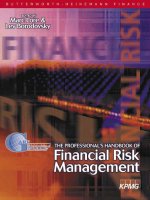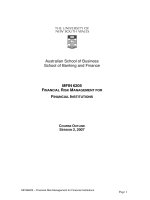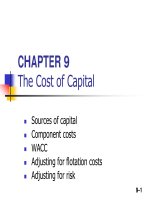Elements of financial risk management chapter 9
Bạn đang xem bản rút gọn của tài liệu. Xem và tải ngay bản đầy đủ của tài liệu tại đây (1004.77 KB, 57 trang )
1
Distributions and Copulas for
Integrated Risk Management
Elements of
Financial Risk Management
Chapter 9
Peter Christoffersen
Elements of Financial Risk Management Second Edition © 2012 by Peter Christoffersen
Overview
2
• In Chapter 6 we built univariate standardized nonnormal
distributions of the shocks
• where zt = rt / t and where D(*) is a standardized
univariate distribution
• In this chapter we want to build multivariate distributions
for our shocks
• where zt is a vector of asset specific shocks, zi,t = ri,t/i,t and
where t is the dynamic correlation matrix
• We assume that the individual variances and the correlation
dynamics have already been modeled
Elements of Financial Risk Management Second Edition © 2012 by Peter Christoffersen
Overview
3
• The chapter proceeds as follows:
• First, we define and plot threshold correlations, which will
be our key graphical tool for detecting multivariate
nonnormality
• Second, we review the multivariate standard normal
distribution, and introduce multivariate standardized
symmetric t distribution and the asymmetric extension
• Third, we define and develop copula modeling idea.
• Fourth, we consider risk management and integrated risk
management using the copula model
Elements of Financial Risk Management Second Edition © 2012 by Peter Christoffersen
Threshold Correlations
4
• Bivariate threshold correlation is useful as a graphical tool for
visualizing nonnormality in multivariate case
• Consider the daily returns on two assets, for example the S&P
500 and the 10-year bond return
• Consider a probability p and define the corresponding
empirical percentile for asset 1 to be r1(p) and similarly for
asset 2, we have r2(p)
• These empirical percentiles, or thresholds, can be viewed as
the unconditional VaR for each asset
Elements of Financial Risk Management Second Edition © 2012 by Peter Christoffersen
Threshold Correlations
• The threshold correlation for probability level p is
• Here we compute the correlation between the two assets
conditional on both of them being below their pth
percentile if p < 0.5 and above their pth percentile if p >
0.5
• In a scatterplot of the two assets we include only the data
in square subsets of the lower-left quadrant when p < 0.5
and we are including only the data in square subsets of
upper-right quadrant when p > 0.5
Elements of Financial Risk Management Second Edition © 2012 by Peter Christoffersen
5
Threshold Correlations
6
• If we compute the threshold correlation for a grid of values
for p and plot the correlations against p then we get the
threshold correlation plot
• Threshold correlation is informative about dependence across
asset returns conditional on both returns being either large
and negative or large and positive
• They therefore tell us about the tail shape of the bivariate
distribution
• Next we compute threshold correlations for the shocks
Elements of Financial Risk Management Second Edition © 2012 by Peter Christoffersen
Figure 9.1: Threshold Correlation for S&P 500
versus 10-Year Treasury Bond Returns
Elements of Financial Risk Management Second Edition © 2012 by Peter Christoffersen
7
Figure 9.2: Threshold Correlation for S&P versus
10-Year Treasury Bond GARCH Shocks
Elements of Financial Risk Management Second Edition © 2012 by Peter Christoffersen
8
Multivariate Distributions
9
• In this section we consider multivariate distributions that
can be combined with GARCH (or RV) and DCC models
to provide accurate risk models for large systems of assets
• We will first review the multivariate standard normal
distribution, then the multivariate standardized symmetric t
distribution, and finally an asymmetric version of the
multivariate standardized t distribution
Elements of Financial Risk Management Second Edition © 2012 by Peter Christoffersen
Multivariate Standard Normal
Distribution
• In the bivariate case we have the standard normal density
with correlation defined by
• where 1-2 is the determinant of the bivariate correlation
matrix
Elements of Financial Risk Management Second Edition © 2012 by Peter Christoffersen
10
Figure 9.3: Simulated Threshold Correlations from
Bivariate Normal Distributions with Various Linear
Correlations
Elements of Financial Risk Management Second Edition © 2012 by Peter Christoffersen
11
Multivariate Standard Normal
Distribution
12
• In the multivariate case with n assets we have the density
with correlation matrix
• Note that each pair of assets in the vector zt will have
threshold correlations that tend to zero for large thresholds
• The 1-day VaR is easily computed via
• where we have portfolio weights wt and the diagonal
matrix of standard deviations Dt+1
Elements of Financial Risk Management Second Edition © 2012 by Peter Christoffersen
Multivariate Standard Normal
Distribution
13
• The 1-day ES is also easily computed using
• In multivariate normal distribution, linear combination of
multivariate normal variables is normally distributed
• The multivariate normal distribution does not adequately
capture the (multivariate) risk of returns
• This means that convenience of normal distribution comes
at a too-high price for risk management purposes
• We therefore consider the multivariate t distribution
Elements of Financial Risk Management Second Edition © 2012 by Peter Christoffersen
Multivariate Standardized t
Distribution
• In Chapter 6 we considered the univariate standardized t
distribution that had the density
• where the normalizing constant is
Elements of Financial Risk Management Second Edition © 2012 by Peter Christoffersen
14
Multivariate Standardized t
Distribution
15
• The bivariate standardized t distribution with correlation
takes the following form:
• where
• Note that d is a scalar here and so the two variables have
the same degree of tail fatness
Elements of Financial Risk Management Second Edition © 2012 by Peter Christoffersen
Figure 9.4: Simulated Threshold Correlations from the
Symmetric t Distribution with Various Parameters
Elements of Financial Risk Management Second Edition © 2012 by Peter Christoffersen
16
Multivariate Standardized t
Distribution
17
• In the case of n assets we have the multivariate t distribution
• Where
• Using the density definition we can construct the
likelihood function
• which can be maximized to estimate d
Elements of Financial Risk Management Second Edition © 2012 by Peter Christoffersen
Multivariate Standardized t
Distribution
18
• The correlation matrix can be preestimated using
• The correlation matrix can also be made dynamic, and
can be estimated using the DCC approach
• An easier estimate of d can be obtained by computing the
kurtosis, 2, of each of the n variables
• The relationship between excess kurtosis and d is
Elements of Financial Risk Management Second Edition © 2012 by Peter Christoffersen
Multivariate Standardized t
Distribution
19
• Using all the information in the n variables we can estimate d using
• where 2,i is sample excess kurtosis of ith variable
• The standardized symmetric n dimensional t variable can
be simulated as follows
Elements of Financial Risk Management Second Edition © 2012 by Peter Christoffersen
Multivariate Standardized t
Distribution
20
• where W is a univariate inverse gamma random variable,
• where U is a vector of multivariate standard normal variables,
• where U and W are independent
• The simulated z will have a mean of zero, a standard deviation
of one, and a correlation matrix
• Once we have simulated MC realizations of vector z we can
simulate MC realizations of the vector of asset returns and
from this the portfolio VaR and ES can be computed by
simulation as well
Elements of Financial Risk Management Second Edition © 2012 by Peter Christoffersen
Multivariate Asymmetric t
Distribution
• Let be an n×1 vector of asymmetry parameters
• The asymmetric t distribution is then defined by
where
Elements of Financial Risk Management Second Edition © 2012 by Peter Christoffersen
21
Multivariate Asymmetric t
Distribution
22
• where
is the so-called modified Bessel function of
the third kind, which can be evaluated in Excel using the
formula besselk(x, (d+n)/2)
• Note that the vector and matrix are constructed so that
the vector of random shocks z will have a mean of zero, a
standard deviation of one, and the correlation matrix
• Note also that if = 0 then
• Note that the asymmetric t distribution will converge to the
symmetric t distribution as the asymmetry parameter
vector goes to a vector of zeros
Elements of Financial Risk Management Second Edition © 2012 by Peter Christoffersen
Figure 9.5: Simulated Threshold Correlations from the
Asymmetric t Distribution with Various Linear
Correlations
Elements of Financial Risk Management Second Edition © 2012 by Peter Christoffersen
23
24
Multivariate Asymmetric t Distribution
• From the density
function
we can construct the likelihood
• which can be maximized to estimate the scalar d and
vector
• The correlation matrix can be preestimated using
• The correlation matrix can be made dynamic, t, and
can be estimated using the DCC approach
Elements of Financial Risk Management Second Edition © 2012 by Peter Christoffersen
25
Multivariate Asymmetric t Distribution
• Simulated values of asymmetric t distribution can be
constructed from inverse gamma and normal variables
• We now have
•
•
•
•
where W is an inverse gamma variable
U is a vector of normal variables,
U and W are independent
Note that the asymmetric t distribution generalizes the
symmetric t distribution by adding a term related to the
same inverse gamma random variable W, which is now
scaled by the asymmetry vector
Elements of Financial Risk Management Second Edition © 2012 by Peter Christoffersen









